I wanted to start today by talking about our skin. As the largest organ in our body, it serves as a barrier to prevent infection, protects our internal workings from injury, regulates our body’s temperature, and, overall, is a reflection of our internal health. Research has shown that you effectively absorb more than 60% of what is put on your skin on average. So, that’s why we try to be really careful about the skincare products that we use, making sure that they are free of harsh, harmful chemicals.
I happen to live a few hours from the desert Southwest and the windy, hot, arid climate is not gentle on anyone’s skin around here, particularly not in the winter. Typical lotions have never really worked for me (and tend to contain lots of harsh ingredients anyway), and, especially, NOT here! So, I was delighted to come across the “MadeOn” recipe for a lotion bar. Not only is it safe and all natural, but it has transformed my family’s skin, year round, and we never have to worry about dry itchy skin or cracked heels in the winter, wind burnt skin in the fall, or parched skin in the summer. The basic recipe only calls for 3 ingredients and you can make the lotion bars in about 30 minutes once you have all your ingredients and supplies together. And, you can adapt the recipe using essential oils or herbs to further tailor the lotion to your senses or your skin’s needs. Without any more delay, here is the basic recipe:
Ingredients
5.25 ounces Coconut Oil
4.25 ounces Unrefined Raw Shea Butter
4.50 ounces Beeswax Pellets
Preparation and Use
1. Measure each of the ingredients into a sauce pan. I usually place my saucepan directly on a kitchen scale to make the weighing/measuring easier.
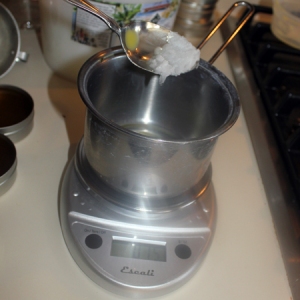
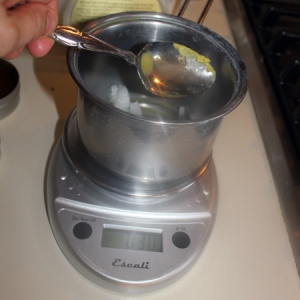
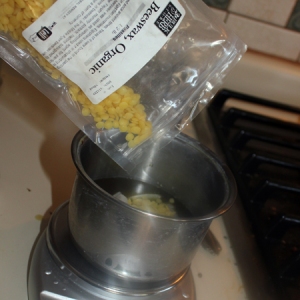
2. Heat the mixture over LOW heat until the beeswax melts.


3. If desired, you can add 10 drops of essential oil per 2 ounces of lotion. So, if you are following this recipe exactly, you can add 70 drops of essential oil.
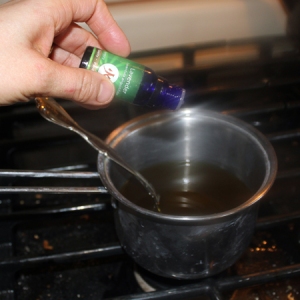
4. Carefully, pour the warm/hot liquid into a soap mold (available at craft stores like JoAnn’s or Hobby Lobby) or salve tin (I bought mine from Bulk Herb Store).
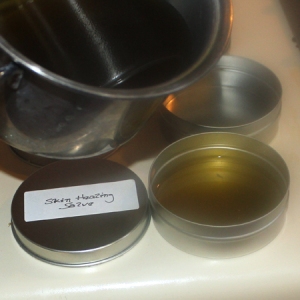
5. Allow the bars to cool completely. If you are using a lotion mold and the bars won’t release easily from the mold, place the mold in the freezer for 5-10 minutes and try again. I usually wrap my molded lotion in wax paper. I labeled them with an address label and stored them in a cool, dry place.
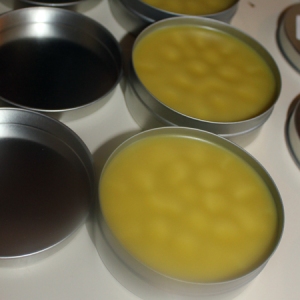
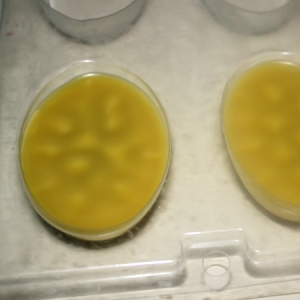
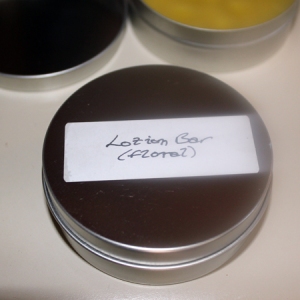

6. Clean your dishes with hot, soapy water.
*Note: If you would like a softer bar, add 20% more coconut oil. If you would like a firmer bar, add 20% more beeswax. To use, simply rub the bar around in your hands. Your body temperature will melt the bar a little, allowing it to come off onto your hands. And, then, wait a minute or two for the ingredients to soak into your skin. Enjoy!
OPTIONAL Recipe Adaptation
Skin Healing Salve:
*For use on cleaned wounds, rashes, insect bites, oils, or chapped/cracked/dry skin.
1. Fill a glass quart jar 1/3 to 1/2 full of the following herbs: echinaea, comfrey, propolis, plantain, yarrow, rosemary, lavendar flowers, and rose petals.
2. Cover the herbs with 10 ounces of the oil of your choice (liquified coconut oil, olive oil, almond oil). Then, very loosely, place a lid over the top of the jar.
3. Place jar in a water bath for 3 days to infuse. To do this, I line the bottom of a crockpot with a hand/kitchen towel, fill the crockpot with water, turn the heat on low, and place the jar inside. I let the oil/herbs incubate in this setup for 3 days, stirring the jar mixture occasionally and refilling the crockpot with water as needed to keep it full.
4. Very carefully, strain the herbs off of the oil by placing cheesecloth (or a clean dishtowel) over the mouth of the jar, inverting the jar, and then allowing the infused oil to drain into a saucepan below it.
5. At this point, you can then take this oil and use it in place of the “coconut oil” in the basic recipe presented above.
Science
Coconut oil is an edible oil extracted from the kernel or meat of matured coconuts harvested from the coconut palm. Coconut oil is easily absorbed into the skin owing to its small molecular structure. Coconut oil aids in the removal of dead skin, revealing the smooth, youthful surface beneath and providing instant relief for chapped skin. Coconut oil also provides long-term healing properties to connective tissue cellular structure by providing it with nutrients and antioxidants, leaving your skin smooth and radiant. Coconut oil is composed of triglycerides that, when applied to the skin, convert to antimicrobial-free fatty acids which bolster infection-fighting abilities. All that, and it’s pure and free of harsh chemicals!
Shea butter is a slightly yellowish-colored fat extracted from the nut of the African shea tree. Shea butter is often used for stretch mark prevention during pregnancy, fighting the effects of aging, repairing rough damaged skin, treating dry skin and eczema, treating minor burns, relieving pain from swelling and arthritis, improving muscle relaxation and stiffness, as a sunscreen, treating dark spots/skin discolorations/blemishes, and healing diaper rashes.
Beeswax has emollient, soothing, and softening properties, which help the skin retain moisture, making it beneficial cosmetically. It’s also great in skincare products because it acts as a thickening agent (because it turns into a semi-solid substance when it comes into contact with air), emulsifier, and humectant. After processing, beeswax remains a biologically active product retaining anti-bacterial properties. It also contains vitamin A, which is essential for human cell development. So, it’s great as an antiseptic and for healing wounds.
Skin healing salve contains a blend of herbs and natural ingredients to numb pain, heal, and soothe. It has astringent properties that draw out infection and poisonous bites. It also has antiseptic and antibacterial properties.
Budget
Lotions can cost as little as $1 for 8 ounces ($0.13 per ounce). The cheapest “all natural” lotions will cost more. The lotion bar presented here costs about $8.83 for 14 ounces ($0.57 per ounce…$2.05 for 5.25 ounces of coconut oil, $3.40 for 4.25 ounces of shea butter, and $3.38 for 4.5 ounces of beeswax). I spent $21 for 54 ounces of coconut oil at Vitacost.com ($0.39 per ounce…I also use the coconut oil for cooking, so buying extra wasn’t a problem for me). I bought 8 ounces of unrefined shea butter from Amazon for $6.40 ($0.80 per ounce). And, I bought 16 ounces of beeswax pellets from Amazon for $12 ($0.75 per ounce). The lotion bar presented hear costs more than the cheapest lotion you’ll be able to find at the Dollar Store or X-Mart; however, it’s probably comparable price-wise to the “all-natural” varieties you’ll find in your local health food store. AND, it works, you’ll know what the ingredients are and where they came from, and you can tailor the scent/texture to your preferences!
from Amazon for $6.40 ($0.80 per ounce). And, I bought 16 ounces of beeswax pellets from Amazon for $12 ($0.75 per ounce). The lotion bar presented hear costs more than the cheapest lotion you’ll be able to find at the Dollar Store or X-Mart; however, it’s probably comparable price-wise to the “all-natural” varieties you’ll find in your local health food store. AND, it works, you’ll know what the ingredients are and where they came from, and you can tailor the scent/texture to your preferences!
or a previous facial moisturizer container because I believe they’re a perfect size for scooping out the lotion without being too cumbersome.
is an edible oil extracted from the kernel or meat of matured coconuts harvested from the coconut palm. Coconut oil is easily absorbed into the skin owing to its small molecular structure. Coconut oil aids in the removal of dead skin, revealing the smooth, youthful surface beneath and providing instant relief for chapped skin. Coconut oil also provides long-term healing properties to connective tissue cellular structure by providing it with nutrients and antioxidants, leaving your skin smooth and radiant. Coconut oil is composed of triglycerides that, when applied to the skin, convert to antimicrobial-free fatty acids which bolster infection-fighting abilities.













